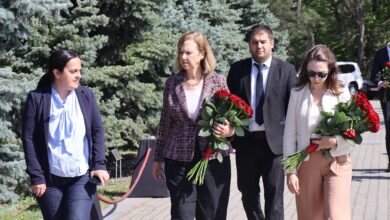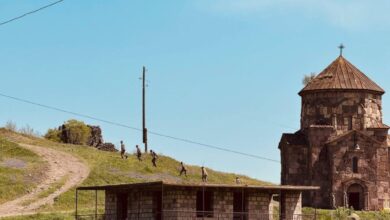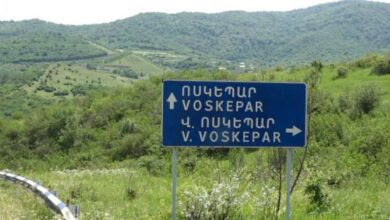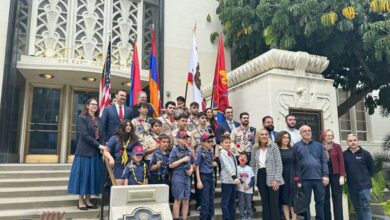Glendale man ends 55-day fast for Armenian Genocide victims
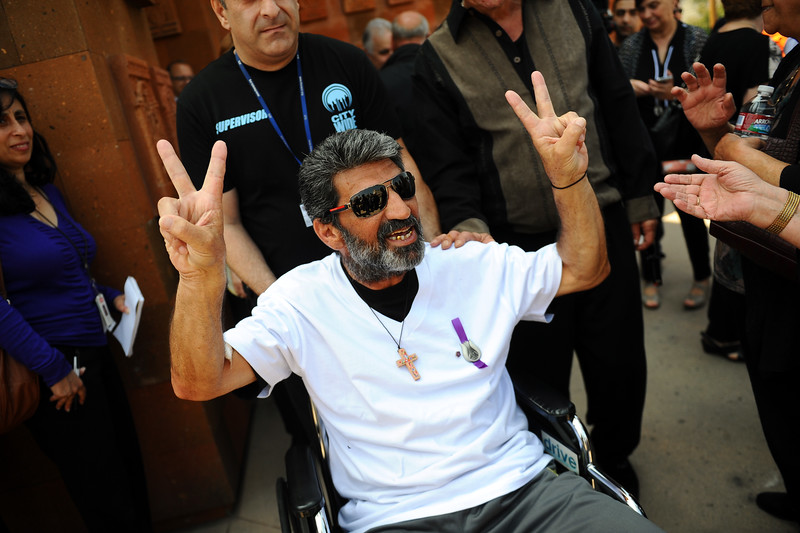
After 55 days spent in a small enclosure with no food and only jugs of water, a thinner and thick-bearded Agasi Vartanyan emerged from his perch Thursday, his voice weak but his spirit swelling with victory for a mission accomplished, The Los Angeles Daily News reports.
Vartanyan needed no help as he used a ladder to climb down from a glass enclosure built on a high platform outside St. Leon Armenian Cathedral in Burbank. A flock of doves was released and a crowd of people clapped as he stepped on the ground, raised his arms to give the peace sign, then sat in a wheelchair. The 55-year-old Glendale man had entered the 12-foot-by-12-foot enclosure on April 3 promising to fast for 55 days to draw attention to the victims of the Armenian Genocide.
He went in weighing 224 pounds and emerged nearly 60 pounds lighter. After a quick check-up by a medical crew, Armenian television reporters swooped in and Vartanyan told the crowd he felt well and that he was grateful for all their support.
“I have great satisfaction,” the Armenian man said through a translator. “You wouldn’t believe the reaction I had from around the world.”
Vartanyan’s hunger strike was meant to cast global attention on what he and many have called an injustice to the 1.5 million Armenians killed under the command of the Ottoman Turks starting a century ago this year. From 1915 to 1923, Armenians were forcibly deported from their homes and killed as part of a systemic ethnic cleansing that also affected Assyrians and Pontic Greeks.
Vartanyan couldn’t participate in the March for Justice last month when more than 100,000 people walked for six miles through the streets of Los Angeles to mark the April 24 centennial. But he said he watched television and saw news reports and was filled with pride when he learned of the great outpouring.
His efforts were supported by the nonprofit Crimes Against Humanity — Never Again (CAHNA), which formed to raise global awareness on genocides past and present. The organization set up a live stream camera of Vartanyan, which drew some 19 million viewers.
That sort of attention will help the organization’s next goal, which will move away from trying to garner recognition of the Armenian Genocide to fighting for justice for those who are descendents, said CAHNA’s president Harut Sassounian, who lost relatives to the genocide. That includes pursuing legal actions against the Turkish government, which has refused to call the events of that time a genocide.
“We Armenians went through hell,” Sassounian said. “We’re continuing the struggle. We want to get back all the lands we lost, the churches that are gone.”
Vartanyan said his goal was to encourage the Armenians of the diaspora to keep fighting for justice. More than 200,000 people of Armenian descent call Los Angeles County home. It is the largest Armenian diaspora outside of the Republic of Armenia.
“I believe you’ll never achieve anything unless you fight for it, struggle for it,” he said. “I did this so that no one will forget the genocide that was committed against my people.”
Vartanyan said he prepared a year for this fast, although he had gone on a similar hunger strike almost 10 years ago in Russia. Back then, he abstained from food for 50 days, in part he said to break illusionist David Blaine’s 44-day fast in London.
It was unclear Thursday if Vartanyan broke any records.
“We do not have a current record holder as we do not currently recognize this category,” said a spokeswoman from Guinness World Records in an e-mail reply.
But those in the crowd said they were proud of him and inspired by his efforts.
“I was very worried about what he was doing,” said Hamlet Pogosian, Vartanyan’s cousin. “I didn’t like what he was doing for health reasons, but I’m proud of what he did for our nation.”
Vartanyan would not discuss the mental and physical struggles he endured, saying he preferred to let the public use their imagination. But halfway through the ordeal, he admitted to reporters he thought a lot about “meat, all kinds of meat.” The front of the enclosure where he spent all his time had one glass wall, allowing the public to see him day and night, though there was some privacy. He was given 55 gallons of water, a few clothes, a cot and a television. He often could be seen pacing back and forth or looking out on the street.
He also wouldn’t say what his first meal would be, but offered a hint through a smile.
“Whatever I eat will be the most delicious thing in the world,” he said.



